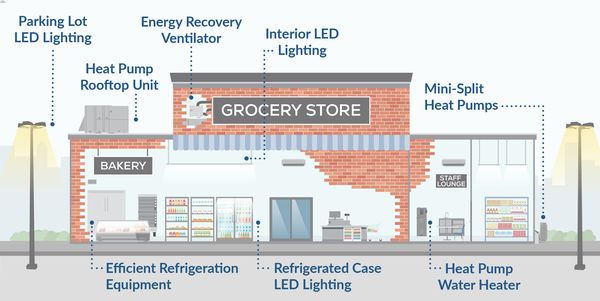Grocery and Convenience

Keeping food cold and illuminating shopping aisles are prerequisites for a grocery or convenience store – and they require a lot of energy. Investing in energy efficiency can not only reduce operating costs, but can increase visibility, reduce food spoilage, and create a more pleasant shopping environment. Ultimately, these improvements translate to higher profits.
Solutions
Heating, Ventilation, and Air-Conditioning (HVAC)
- Grocery and convenience stores can save money and increase equipment reliability by making energy-efficient choices when installing or replacing heating, cooling or ventilation (HVAC) equipment. Efficiency Maine offers incentives for:
HVAC Solutions
- Ductless Heat Pumps
- Variable Refrigerant Flow (VRF) Systems
- Heat Pump Rooftop Units (RTUs)
- Energy Recovery Ventilators (ERVs)
- And more
Click here to learn more.
Lighting
- Proper lighting is a necessity in grocery and convenience stores to maintain a productive and safe environment at a lower operating cost. High-efficiency fixtures and lighting controls can enhance aesthetics while decreasing cost. Efficiency Maine offers incentives for interior and exterior high-efficiency lighting solutions including:
Lighting Solutions
- LED Retrofit Kits
- New LED Fixtures
- Exterior Lighting
- And more
Click here to learn more.
Refrigeration
- Upgrading to high-efficiency display coolers can be a big energy savings for grocery and convenience stores. If replacing equipment is not a viable option, custom add-ons and efficient component retrofits can improve the performance of existing refrigeration systems.
Refrigeration Solutions
- Scroll Compressors
- High-Efficiency Evaporator Fan Motors
- Strip Curtain for Cooler or Freezer
- Door Heater Controls for Cooler or Freezer
- Evaporator Fan Motor Controls
- Floating Head Pressure Controls
- And more
Click here to learn more.
Commercial Kitchen Ventilation
- Demand Control Kitchen Ventilation systems regulate fan speed depending on real-time demand rather than functioning at full capacity all day. Demand control ventilation systems can reduce energy required by ventilation as much as 65%.
Click here to learn more.
Water Heating
- Businesses can reduce water heating costs by upgrading to high-efficiency water heating systems and choosing a system that meets each business’s needs.
Click here to learn more.
Custom Solutions
- Don’t see your energy solution listed above? Efficiency Maine also offers incentives for customized, site-specific energy solutions, including integrated HVAC controls, building envelope upgrades, combined heat and power installations, and more. Click here for more information on the Custom Program.
Plug Loads
Administrative offices, break rooms, and check out aisles use equipment that can have a big electrical draw, even when not in use. Consider purchasing ENERGY STAR®-certified equipment when next updating office equipment, which is 30-75% more efficient than standard equipment. There are also resources to help you identify energy demands of other plug loads, some of which may be able to be powered down during off-hours.
Custom Case Studies
Hannaford Bros Co.
In an effort to reduce the operating costs associated with its extensive refrigeration systems, Hannaford Bros Co. initiated a significant energy efficiency retrofit initiative in 2015: the company proposed installing energy-saving doors and high- efficiency lighting in refrigerated beer and dairy cases at 11 stores across the state. The existing refrigeration cases represented a significant savings opportunity; they were 12-foot long open-air displays, equipped with standard T-8 lighting. With the help of Efficiency Maine, Hannaford was able to install six 2-foot doors along each 12-foot stretch, as well as replace the old lighting with LEDs. In addition to electric energy savings associated with reduced refrigeration and lighting loads, Hannaford saw thermal savings resulting from reduced space heating requirements.
- Project cost: $357,728
- Efficiency Maine incentive: $120,412
- Annual energy savings: 586,176 kWh and 6,140 MMBtu
- Return on investment: 1.32 with incentive, 1.99 without incentive
Get Started
 Ready to upgrade your facility with high-efficiency equipment and appliances? Work with an Efficiency Maine Qualified Partner in order to be eligible for these incentives. See our Qualified Partner video for more information on this process.
Ready to upgrade your facility with high-efficiency equipment and appliances? Work with an Efficiency Maine Qualified Partner in order to be eligible for these incentives. See our Qualified Partner video for more information on this process.
Click here to find a Qualified Partner working near you. If you work with a contractor that is not yet a Qualified Partner, urge your contractor to find out more information here. As part of the project approval process, you will accept the C&I Prescriptive Program’s Terms and Conditions. If you’re interested in becoming a Qualified Partner, click here to see our Become A Qualified Partner page.
If you’re interested in getting started with an energy efficiency project in your business but don’t know where to start, you can sign-up for a virtual customer consultation here.
Additional Information and Resources
Energy Savings Tips for Small Businesses: Grocery and Convenience Stores. Click here for information from ENERGY STAR.
